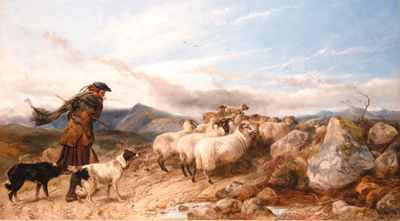
Price Realized £52,875
signed and dated 'R Ansdell/1866' (lower right)
oil on canvas
30 x 54 in. (76.2 x 137.2 cm.)
The figure of a Highland shepherd, braving the elements and herding his flock is one of Ansdell's most enduring images. Such was its popularity that the artist painted various versions of the scene, each, though of similar dimensions, differing in its composition. The first, entitled Crossing the Moor and with the shepherd heading from right to left, was exhibited at the British Institution in 1863 where the critic of the Art Journal praised a picture of 'sheep, heather, dogs and Scotch shepherd, all vigorous even to violence'. That picture is now in the Tunbridge Wells Museum and Art Gallery as part of the Ashton Bequest. A second picture entitled Crossing a Burn, with the shepherd at the left raising his cape to gather his flock across a footbridge, was sold at Sotheby's Scone Palace, 13 April 1981, lot 177. A third, entitled Changing to Winter Pastures, belonging to the late Hon. Simon Fraser, Master of Lovat, was sold at Christie's London, 4 November 1994, lot 90.
Richard Ansdell was born in Liverpool and educated at the Blue Coat School. He studied under W.C. Smith, a portrait painter, and then worked for an art dealer in Liverpool, before entereing the Liverpool Academy in 1836, at the age of twenty-one. He first exhibited at the Royal Academy in 1840, showing two pictures, one of which was Grouse-shooting: Luncheon on the Moors, no. 485, a sporting subject of a type to which he was to return for much of his work. Even many of his historical paintings such as Mary Queen of Scots returning from the Chase, exhibited at the Royal Academy in 1844 had sporting associations.
In 1845 and 1846, Ansdell was elected President of the Liverpool Academy. He moved permanently to London in 1847. It was there that he began to work with Thomas Creswick and William Powell Frith on several collaborations, and established his long-lasting reptuation. James Dafforne of the Art Journal (1860, p. 223) noted 'That Mr. Ansdell has closely studied animal life, that he represents it faithfully, vigorously, and pituresquely, and that his productions are among the best of their kind which our school - and indeed, any other - has brought forward, is to pay him and them no higher compliment than is merited. If we had no Landseer, Ansdell would, unquestionably, occupy the very foremost place in this department of Art ...'.
No comments:
Post a Comment